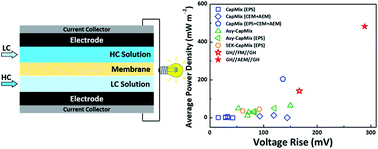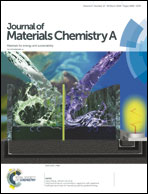High performance concentration capacitors with graphene hydrogel electrodes for harvesting salinity gradient energy†
Abstract
Salinity gradient energy (SGE) is the energy available from the salinity difference between freshwater and saltwater. Herein, we propose a concentration capacitor as a novel capacitive mixing (CapMix) technique to harvest SGE. The concentration capacitor comprises identical electrodes and a membrane that separates concentrated and diluted solutions that alternately flow through the capacitor. Graphene hydrogel (GH) electrodes and a filtration membrane (FM) or an anion exchange membrane (AEM) are used to construct GH//FM//GH and GH//AEM//GH concentration capacitors. These concentration capacitors show excellent performance in harvesting SGE, particularly the GH//AEM//GH concentration capacitor, whose voltage rise and average power density can reach 288.5 mV and 482.4 mW m−2, respectively, which are higher than those obtained with other CapMix techniques. The outstanding performance is associated with the double-channel construction, the membrane potential, and the macroporous structure and abundant negative charge of the GH electrodes. Our results show that the concentration capacitor is a promising approach for efficiently extracting SGE.

- This article is part of the themed collection: 2018 Journal of Materials Chemistry A HOT Papers


 Please wait while we load your content...
Please wait while we load your content...